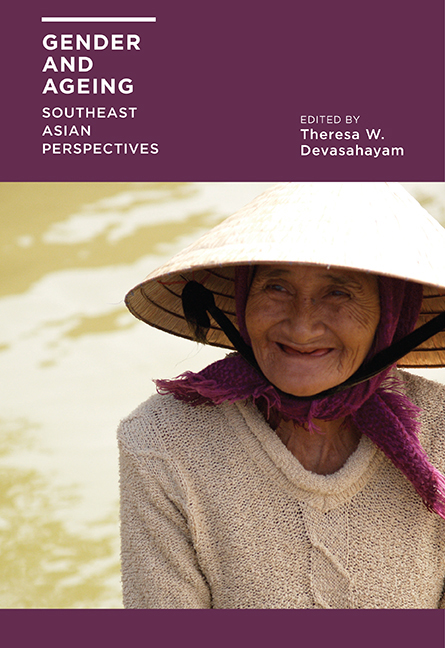Book contents
- Frontmatter
- Contents
- List of Tables and Figures
- Acknowledgments
- Contributors
- 1 Growing Old in Southeast Asia: What Do We Know about Gender?
- 2 Gender and Ageing in Thailand: A Situation Analysis of Older Women and Men
- 3 Gender and Well-being of Older Persons in Cambodia
- 4 Preparations for Old Age and Social Participation of Present and Future Older Persons in Thailand: Gender Difference
- 5 Gender and Health Status among Older Adults in Vietnam
- 6 Ageing and Gender Preferences in Rural Indonesia
- 7 Exploring the Experiences of Older Men and Women in Caregiving and Care-receiving in Sarawak, Malaysia
- 8 An “Active Ageing” Approach to Living Alone: Older Men and Women Living in Rental Flats in Singapore
- 9 Ethnic Patterns and Styles of Active Ageing among Widows and Widowers in Singapore
- 10 Employment Patterns of Older Women in Indonesia
- 11 Gender Differentials in Work and Income among Older Malaysians
- 12 Gender and Economic Well-being among Older Filipinos
- 13 Work, Retirement and the Gender Divide in the Philippines
- Index
11 - Gender Differentials in Work and Income among Older Malaysians
Published online by Cambridge University Press: 21 October 2015
- Frontmatter
- Contents
- List of Tables and Figures
- Acknowledgments
- Contributors
- 1 Growing Old in Southeast Asia: What Do We Know about Gender?
- 2 Gender and Ageing in Thailand: A Situation Analysis of Older Women and Men
- 3 Gender and Well-being of Older Persons in Cambodia
- 4 Preparations for Old Age and Social Participation of Present and Future Older Persons in Thailand: Gender Difference
- 5 Gender and Health Status among Older Adults in Vietnam
- 6 Ageing and Gender Preferences in Rural Indonesia
- 7 Exploring the Experiences of Older Men and Women in Caregiving and Care-receiving in Sarawak, Malaysia
- 8 An “Active Ageing” Approach to Living Alone: Older Men and Women Living in Rental Flats in Singapore
- 9 Ethnic Patterns and Styles of Active Ageing among Widows and Widowers in Singapore
- 10 Employment Patterns of Older Women in Indonesia
- 11 Gender Differentials in Work and Income among Older Malaysians
- 12 Gender and Economic Well-being among Older Filipinos
- 13 Work, Retirement and the Gender Divide in the Philippines
- Index
Summary
INTRODUCTION
The population of Malaysia is ageing gradually. Between 1970 and 2010, the proportion of the population age 60 and above to the total population increased from 5.2 per cent to 7.9 per cent. The number of older persons increased more than fourfold from a little more than half a million in 1970 to 2.25 million in 2010. By 2020, the number of older persons is projected to reach 3.2 million out of a population of about 32 million. The various ethnic groups in Malaysia are at different stages of ageing. In 2010, 12.2 per cent of the Chinese were age 60 and above as compared to 6.2 per cent of the other indigenous groups, 7.3 per cent among the Malays, and 7.9 per cent among the Indians.
Life expectancy at birth has gone up from 66.5 years for males and 71 years for females during the early 1970s to 71.9 years for males and 77 years for females in 2010 (Department of Statistics 2001 and 2011). According to the 2010 life tables, of those who would be alive at age 55, the number of years expected to be lived is about 21.5 years for males and 24.5 years for females. Gender differentials in life expectancy at various ages have given rise to feminization of the older population.
Despite the substantial increase in life expectancy, the retirement age remains at 55 years until recently for workers in the private sector. However, following the adoption of the Minimum Retirement Age Act 2012 by Parliament in the June/July session, the minimum retirement age of 60 for private sector workers was gazetted on 1 January 2013, and came into effect on 1 July 2013. Retirement age in the public sector was raised from 55 to 56 in 2001, to 58 in 2008 and further to 60 in 2013. With structural changes in the economy, an increasing number of workers have moved from the informal to the formal sector, and are subject to mandatory retirement.
- Type
- Chapter
- Information
- Gender and AgeingSoutheast Asian Perspectives, pp. 267 - 287Publisher: ISEAS–Yusof Ishak InstitutePrint publication year: 2014



